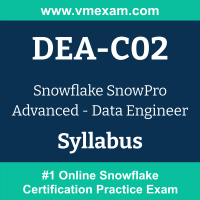 The Snowflake DEA-C02 exam preparation guide is designed to provide candidates with necessary information about the SnowPro Advanced - Data Engineer exam. It includes exam summary, sample questions, practice test, objectives and ways to interpret the exam objectives to enable candidates to assess the types of questions-answers that may be asked during the Snowflake Certified SnowPro Advanced - Data Engineer Certification exam.
The Snowflake DEA-C02 exam preparation guide is designed to provide candidates with necessary information about the SnowPro Advanced - Data Engineer exam. It includes exam summary, sample questions, practice test, objectives and ways to interpret the exam objectives to enable candidates to assess the types of questions-answers that may be asked during the Snowflake Certified SnowPro Advanced - Data Engineer Certification exam.
It is recommended for all the candidates to refer the DEA-C02 objectives and sample questions provided in this preparation guide. The Snowflake SnowPro Advanced - Data Engineer certification is mainly targeted to the candidates who want to build their career in Advance domain and demonstrate their expertise. We suggest you to use practice exam listed in this cert guide to get used to with exam environment and identify the knowledge areas where you need more work prior to taking the actual Snowflake SnowPro Advanced - Data Engineer exam.
Snowflake DEA-C02 Exam Summary:
| Exam Name | Snowflake SnowPro Advanced - Data Engineer |
| Exam Code | DEA-C02 |
| Exam Price | $375 USD |
| Duration | 115 minutes |
| Number of Questions | 65 |
| Passing Score | 750 + Scaled Scoring from 0 - 1000 |
| Recommended Training / Books |
Snowflake Data Engineering Training SnowPro Advanced: Data Engineer Study Guide |
| Schedule Exam | PEARSON VUE |
| Sample Questions | Snowflake DEA-C02 Sample Questions |
| Recommended Practice | Snowflake Certified SnowPro Advanced - Data Engineer Certification Practice Test |
Snowflake SnowPro Advanced - Data Engineer Syllabus:
| Section | Objectives | Weight |
|---|---|---|
| Data Movement |
- Given a data set, load data into Snowflake.
- Ingest data of various formats through the mechanics of Snowflake.
- Troubleshoot data ingestion.
- Design, build, and troubleshoot continuous data pipelines.
- Analyze and differentiate types of data pipelines.
- Install, configure, and use connectors to connect to Snowflake.
- Design and build data sharing solutions.
- Outline when to use External Tables and define how they work.
|
26% |
| Performance Optimization |
- Troubleshoot underperforming queries.
- Given a scenario, configure a solution for the best performance.
- Monitor continuous data pipelines.
|
21% |
| Storage and Data Protection |
- Implement and manage data recovery features in Snowflake.
- Use System Functions to analyze Micro-partitions.
- Use Time Travel and Cloning to create new development environments.
|
14% |
| Data Governance |
- Monitor data.
- Establish and maintain data protection.
|
14% |
| Data Transformation |
- Define User-Defined Functions (UDFs) and outline how to use them.
- Define and create External Functions.
- Design, build, and leverage Stored Procedures.
- Handle and transform semi-structured data.
- Handle and process unstructured data.
- Use Snowpark for data transformation.
|
25% |
